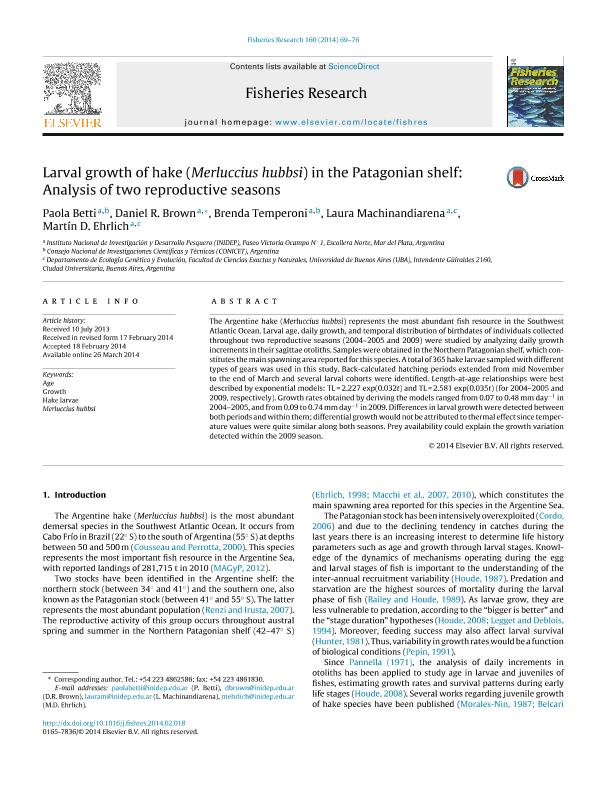Mostrar el registro sencillo del ítem
dc.contributor.author
Betti, Paola

dc.contributor.author
Brown, Daniel Roberto

dc.contributor.author
Temperoni, Brenda

dc.contributor.author
Machinandiarena, Laura
dc.contributor.author
Ehrlich, Martín David

dc.date.available
2017-10-02T18:40:52Z
dc.date.issued
2014-02
dc.identifier.citation
Betti, Paola; Brown, Daniel Roberto; Temperoni, Brenda; Machinandiarena, Laura; Ehrlich, Martín David; Larval growth of hake (Merluccius hubbsi) in the Patagonian shelf: Analysis of two reproductive seasons; Elsevier Science; Fisheries Research; 160; 2-2014; 69-76
dc.identifier.issn
0165-7836
dc.identifier.uri
http://hdl.handle.net/11336/25636
dc.description.abstract
The Argentine hake (Merluccius hubbsi) represents the most abundant fish resource in the Southwest Atlantic Ocean. Larval age, daily growth, and temporal distribution of birthdates of individuals collected throughout two reproductive seasons (2004–2005 and 2009) were studied by analyzing daily growth increments in their sagittae otoliths. Samples were obtained in the Northern Patagonian shelf, which constitutes the main spawning area reported for this species. A total of 365 hake larvae sampled with different types of gears was used in this study. Back-calculated hatching periods extended from mid November to the end of March and several larval cohorts were identified. Length-at-age relationships were best described by exponential models: TL = 2.227 exp(0.032t) and TL = 2.581 exp(0.035t) (for 2004–2005 and 2009, respectively). Growth rates obtained by deriving the models ranged from 0.07 to 0.48 mm day−1 in 2004–2005, and from 0.09 to 0.74 mm day−1 in 2009. Differences in larval growth were detected between both periods and within them; differential growth would not be attributed to thermal effect since temperature values were quite similar along both seasons. Prey availability could explain the growth variation detected within the 2009 season.
dc.format
application/pdf
dc.language.iso
eng
dc.publisher
Elsevier Science

dc.rights
info:eu-repo/semantics/openAccess
dc.rights.uri
https://creativecommons.org/licenses/by-nc-sa/2.5/ar/
dc.subject
Age
dc.subject
Growth
dc.subject
Hake Larvae
dc.subject
Merluccius Hubbsi
dc.subject.classification
Bioquímica y Biología Molecular

dc.subject.classification
Ciencias Biológicas

dc.subject.classification
CIENCIAS NATURALES Y EXACTAS

dc.subject.classification
Otras Agricultura, Silvicultura y Pesca

dc.subject.classification
Agricultura, Silvicultura y Pesca

dc.subject.classification
CIENCIAS AGRÍCOLAS

dc.title
Larval growth of hake (Merluccius hubbsi) in the Patagonian shelf: Analysis of two reproductive seasons
dc.type
info:eu-repo/semantics/article
dc.type
info:ar-repo/semantics/artículo
dc.type
info:eu-repo/semantics/publishedVersion
dc.date.updated
2017-09-29T14:45:13Z
dc.journal.number
160
dc.journal.pagination
69-76
dc.journal.pais
Países Bajos

dc.journal.ciudad
Amsterdam
dc.description.fil
Fil: Betti, Paola. Instituto Nacional de Investigaciones y Desarrollo Pesquero; Argentina
dc.description.fil
Fil: Brown, Daniel Roberto. Instituto Nacional de Investigaciones y Desarrollo Pesquero; Argentina
dc.description.fil
Fil: Temperoni, Brenda. Consejo Nacional de Investigaciones Científicas y Técnicas. Centro Científico Tecnológico Mar del Plata. Instituto de Investigaciones Marinas y Costeras. Subsede Instituto Nacional de Investigación y Desarrollo Pesquero; Argentina
dc.description.fil
Fil: Machinandiarena, Laura. Instituto Nacional de Investigaciones y Desarrollo Pesquero; Argentina. Universidad de Buenos Aires. Facultad de Ciencias Exactas y Naturales; Argentina
dc.description.fil
Fil: Ehrlich, Martín David. Instituto Nacional de Investigaciones y Desarrollo Pesquero; Argentina. Consejo Nacional de Investigaciones Científicas y Técnicas; Argentina. Universidad de Buenos Aires. Facultad de Ciencias Exactas y Naturales; Argentina
dc.journal.title
Fisheries Research

dc.relation.alternativeid
info:eu-repo/semantics/altIdentifier/url/http://www.sciencedirect.com/science/article/pii/S0165783614000587
dc.relation.alternativeid
info:eu-repo/semantics/altIdentifier/doi/http://dx.doi.org/10.1016/j.fishres.2014.02.018
Archivos asociados
